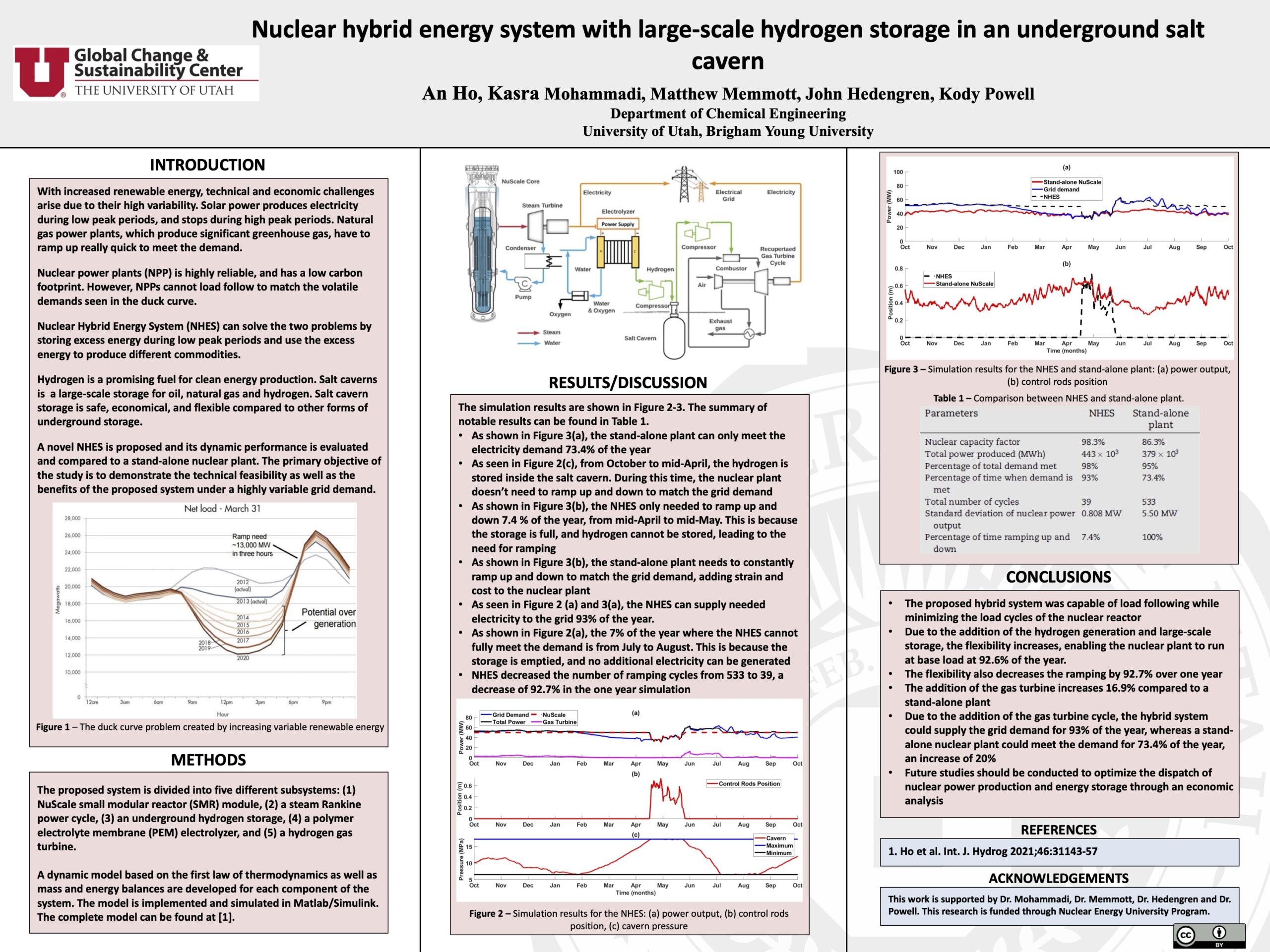Dynamic simulation of a novel nuclear hybrid energy system with large-scale hydrogen storage in an underground salt cavern
–An Ho, Kasra Mohammadi, Matthew Memmott, John Hedengren, Kody M. Powell
[bs_collapse id=”collapse_bb86-afd7″]
[bs_citem title=”Bio” id=”citem_e610-6c22″ parent=”collapse_bb86-afd7″]
I am a Ph.D. candidate in the Department of Chemical Engineering, working under the advisement of Dr. Kody Powell. My research is in nuclear hybrid energy systems, developing dynamic models of such systems to create clean energy.
[/bs_citem]
[bs_citem title=”Abstract” id=”citem_eca8-96a7″ parent=”collapse_bb86-afd7″]
A nuclear-hybrid system is proposed as a flexible system for load following. The system consists of a nuclear reactor, a Rankine cycle, a hydrogen electrolyzer, hydrogen storage in an underground salt cavern, and a Brayton cycle to generate electricity to meet peak demand. A dynamic mathematical model is developed for each subsystem. To evaluate the potential benefits of the system, a one-year study is conducted, using scaled grid demand data from ISO New England. The simulation results show that the system can meet the demand of the grid for 93% of the year, while decreasing the number of ramping cycles of the nuclear reactor by 92.7%. The system only ramps up and down 7.4% of the year, which increased the nuclear capacity factor from 86.3% to 98.3%. The simulation results show that the proposed system improves the flexibility of nuclear power plants, provides more electricity, and reduces greenhouse gas emissions.
[/bs_citem]
[bs_citem title=”Narrative” id=”citem_780c-0f71″ parent=”collapse_bb86-afd7″]
Renewable energy is inconsistent and variable, meaning it cannot generate electricity on demand. This creates economic and technical challenges. To meet the demands that are not met by renewable energy sources, load following power plants are usually needed to replace the renewable sources during peak demands. These power plants usually use coal, natural gas, or diesel, which have high cost and emit significant greenhouse gases. Nuclear power plants are clean sources of energy and reliable, but cannot load follow to maintain the demand-supply balance. A solution is to integrate nuclear plants with hybrid systems that can store excess energy when demand is low. Hydrogen is a clean and promising fuel to be stored using excess energy from nuclear power plants. Salt cavern is a cheap and proven technology for storage. Salt cavern has been used to store oil, natural gas, and hydrogen.
A novel nuclear hybrid energy system (NHES) is proposed, consists of a nuclear reactor, hydrogen generation, salt cavern storage, and gas turbine. A dynamic mathematical model is developed for each subsystem of the NHES. To evaluate the potential benefits of the system, a one-year study is conducted, using scaled grid demand data from ISO New England. The dynamic simulation results show that the system is capable of meeting the demand of the grid without additional electricity from outside sources for 93% of the year, while decreasing the number of ramping cycles of the nuclear reactor by 92.7%. There is also potential for economic benefits as the system only had to ramp up and down 7.4% of the year, which increased the nuclear capacity factor from 86.3% to 98.3%. The simulation results show that the proposed hybrid system improves the flexibility of nuclear power plants, provides more electricity, and reduces greenhouse gas emissions.
[/bs_citem]
[/bs_collapse]

